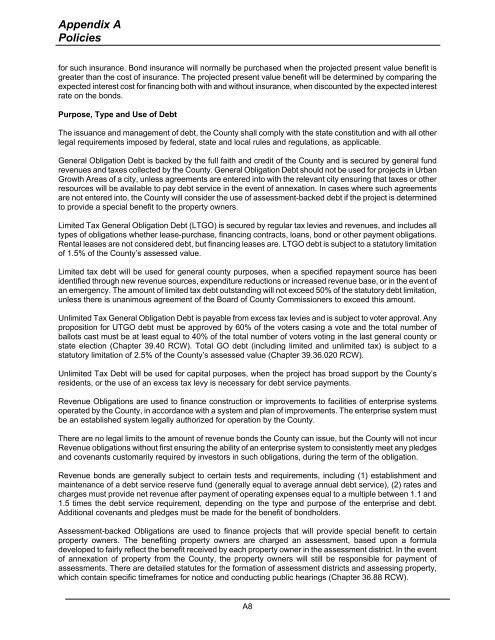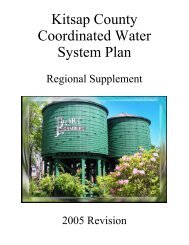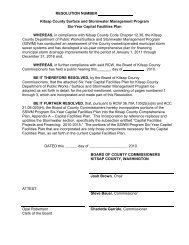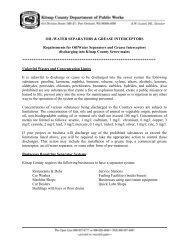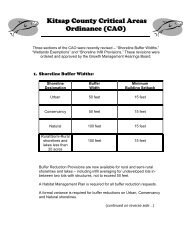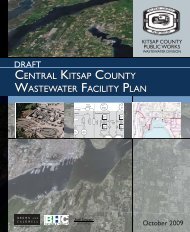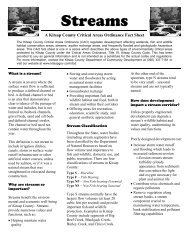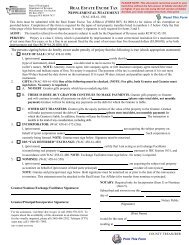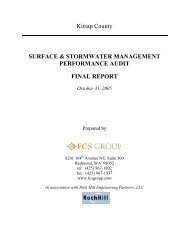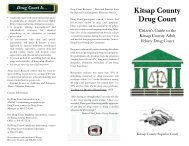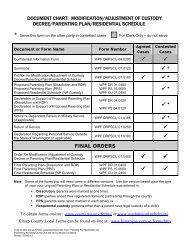2008 Budget Book - Kitsap County Government
2008 Budget Book - Kitsap County Government
2008 Budget Book - Kitsap County Government
Create successful ePaper yourself
Turn your PDF publications into a flip-book with our unique Google optimized e-Paper software.
Appendix A<br />
Policies<br />
for such insurance. Bond insurance will normally be purchased when the projected present value benefit is<br />
greater than the cost of insurance. The projected present value benefit will be determined by comparing the<br />
expected interest cost for financing both with and without insurance, when discounted by the expected interest<br />
rate on the bonds.<br />
Purpose, Type and Use of Debt<br />
The issuance and management of debt, the <strong>County</strong> shall comply with the state constitution and with all other<br />
legal requirements imposed by federal, state and local rules and regulations, as applicable.<br />
General Obligation Debt is backed by the full faith and credit of the <strong>County</strong> and is secured by general fund<br />
revenues and taxes collected by the <strong>County</strong>. General Obligation Debt should not be used for projects in Urban<br />
Growth Areas of a city, unless agreements are entered into with the relevant city ensuring that taxes or other<br />
resources will be available to pay debt service in the event of annexation. In cases where such agreements<br />
are not entered into, the <strong>County</strong> will consider the use of assessment-backed debt if the project is determined<br />
to provide a special benefit to the property owners.<br />
Limited Tax General Obligation Debt (LTGO) is secured by regular tax levies and revenues, and includes all<br />
types of obligations whether lease-purchase, financing contracts, loans, bond or other payment obligations.<br />
Rental leases are not considered debt, but financing leases are. LTGO debt is subject to a statutory limitation<br />
of 1.5% of the <strong>County</strong>’s assessed value.<br />
Limited tax debt will be used for general county purposes, when a specified repayment source has been<br />
identified through new revenue sources, expenditure reductions or increased revenue base, or in the event of<br />
an emergency. The amount of limited tax debt outstanding will not exceed 50% of the statutory debt limitation,<br />
unless there is unanimous agreement of the Board of <strong>County</strong> Commissioners to exceed this amount.<br />
Unlimited Tax General Obligation Debt is payable from excess tax levies and is subject to voter approval. Any<br />
proposition for UTGO debt must be approved by 60% of the voters casing a vote and the total number of<br />
ballots cast must be at least equal to 40% of the total number of voters voting in the last general county or<br />
state election (Chapter 39.40 RCW). Total GO debt (including limited and unlimited tax) is subject to a<br />
statutory limitation of 2.5% of the <strong>County</strong>’s assessed value (Chapter 39.36.020 RCW).<br />
Unlimited Tax Debt will be used for capital purposes, when the project has broad support by the <strong>County</strong>’s<br />
residents, or the use of an excess tax levy is necessary for debt service payments.<br />
Revenue Obligations are used to finance construction or improvements to facilities of enterprise systems<br />
operated by the <strong>County</strong>, in accordance with a system and plan of improvements. The enterprise system must<br />
be an established system legally authorized for operation by the <strong>County</strong>.<br />
There are no legal limits to the amount of revenue bonds the <strong>County</strong> can issue, but the <strong>County</strong> will not incur<br />
Revenue obligations without first ensuring the ability of an enterprise system to consistently meet any pledges<br />
and covenants customarily required by investors in such obligations, during the term of the obligation.<br />
Revenue bonds are generally subject to certain tests and requirements, including (1) establishment and<br />
maintenance of a debt service reserve fund (generally equal to average annual debt service), (2) rates and<br />
charges must provide net revenue after payment of operating expenses equal to a multiple between 1.1 and<br />
1.5 times the debt service requirement, depending on the type and purpose of the enterprise and debt.<br />
Additional covenants and pledges must be made for the benefit of bondholders.<br />
Assessment-backed Obligations are used to finance projects that will provide special benefit to certain<br />
property owners. The benefiting property owners are charged an assessment, based upon a formula<br />
developed to fairly reflect the benefit received by each property owner in the assessment district. In the event<br />
of annexation of property from the <strong>County</strong>, the property owners will still be responsible for payment of<br />
assessments. There are detailed statutes for the formation of assessment districts and assessing property,<br />
which contain specific timeframes for notice and conducting public hearings (Chapter 36.88 RCW).<br />
A8


